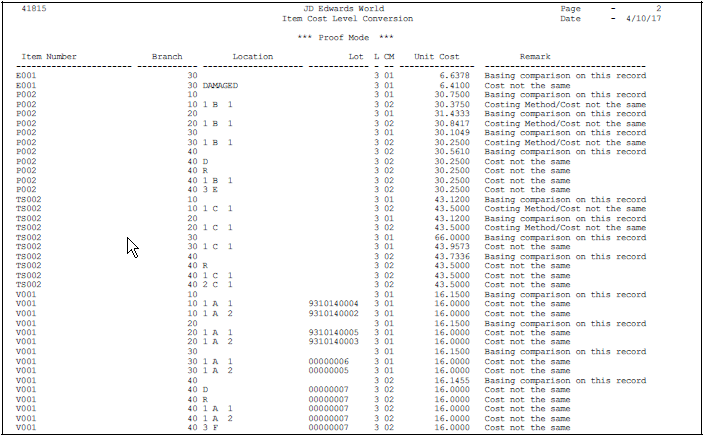5 Create Simulated Costs
This chapter contains these topics:
5.1 Creating Simulated Costs
You can use the Product Costing system to calculate costs on a "what if" basis. You can view the effect of any changes you want to incorporate without altering the frozen standard costs. In addition, you can simulate cost change scenarios (rollups) as many times as needed before you finalize the changes during the frozen update process. If you perform costing by work center, the system creates simulated costs at the work center level.
For example, you can use simulated rollups to:
-
Simulate an increase in material costs
-
Forecast the impact of changes to labor rates
-
Develop strategies for pricing, contractual, or labor negotiation
The simulated rollup uses information from the following tables to generate costs:
The Simulate Cost Rollup program sums the costs of all the components in each level of the parent item's bill of material to arrive at a total cost for the parent item.
This section contains the following:
5.2 Creating the Costing Exceptions Report
From Daily Product Costing (G3014), choose Periodic Product Costing
From Periodic Product Costing (G3023), choose Costing Exceptions
Before you roll up simulated costs, run the Costing Exceptions program. The program generates a report, which lists any problems associated with an item. An example of a problem is an item without a routing. You should correct the problems and run the Costing Exceptions program again before creating a simulated rollup.
Figure 5-1 Item Cost Level Conversion report

Description of "Figure 5-1 Item Cost Level Conversion report"
5.2.1 What You Should Know About Processing Options
Indicate in the processing options the minimum level of error messages that you want to include in the report. You can define severity levels and error messages specific to your company by using Vocabulary Overrides. For example, if labor hours are zero is important to your company, then you might want to assign this error message a higher severity level.
The text of the message can also be changed, but it must maintain the same meaning as the original message defined by JD Edwards World. For example, you could change the message text labor hours are zero to no labor hours.
The following are examples of errors on which the system searches and the severity level to which they are assigned by JD Edwards World.
| Severity | Message Text |
|---|---|
| 50 | Manufactured item with no BOM |
| 40 | No rates for work center |
| 30 | No labor rate (for selected cost method) |
| 30 | No cost component - material cost |
| 30 | No setup labor rate (for selected cost method) |
| 30 | No variable overhead rate (for selected cost method) |
| 30 | No fixed overhead rate (for selected cost method) |
| 30 | No work center machine run rate (for selected cost method) |
| 30 | No work center machine variable overhead rate (for selected cost method) |
| 30 | No work center machine fixed overhead rate (for selected cost method) |
| 20 | Purchased part with BOM |
| 20 | BOM component with no quantity per |
| 10 | Setup hours are zero |
| 10 | Machine hours are zero |
| 10 | Labor hours are zero |
| 10 | Extras at standard and not at current or future or vice versa |
| 10 | No accounting lot size set up (future) |
5.3 Creating a Simulated Rollup
From Manufacturing Systems (G3), choose Product Costing
From Daily Product Costing (G3014), choose Simulate Rollup
Use the Simulate Cost Rollup program to calculate costs on a "what if" basis. If you perform costing by work center, the system creates simulated costs at the work center level. Then, you can view the results on Enter/Change Cost Components.
You can perform simulated rollups and frozen updates for any cost method, excluding 02. Manufacturing Accounting system uses frozen standard costs (cost method 07), if standard costing is indicated in Manufacturing Constants.
To choose a bill of material and routing, the program searches first for a bill whose batch quantity matches the accounting cost quantity. If no such bill is found, the program uses the zero batch bill. The zero batch bill has a blank batch quantity on the header section. The component item(s) quantity per is the amount required to build one unit of the parent item.
5.3.1 Cumulative Yield
Cumulative yield, defined on the routing, affects labor and machine hours in the rollup calculations. There must be enough hours expended to obtain 100% yield at the last operation. In a series of routings, the hours must be adjusted accordingly. The following example illustrates how costing of hours is affected by cumulative yield:
Cumulative Yield = 85% (0.85)
| Yield | Labor | Machine | Setup |
|---|---|---|---|
| Without Yield | 5 | 5 | 5 |
| With Yield | 5.88 | 5.88 | 5 |
For each operation, the labor and machine hours are adjusted by dividing the hours by the cumulative yield. Setup hours are not affected.
5.3.2 Operation Scrap
Operation scrap, defined on the bill of material, affects material cost calculations in the rollup. There must be enough material at each operation in order to obtain 100% yield at the last operation. When material cost is calculated, the quantity of the components is adjusted accordingly. The following example illustrates the effect of operation scrap on costing:
Parent = A
Component = B
Quantity per = 3
Cost of B = 5.00
Operation scrap = 8%
Cost of B rolled into parent item A = 3 x 1.08 x 5 = 16.20.